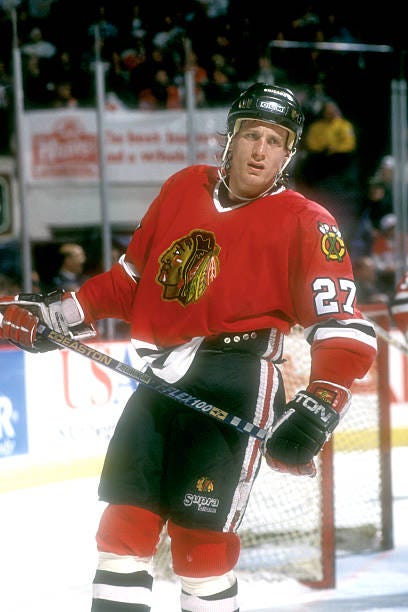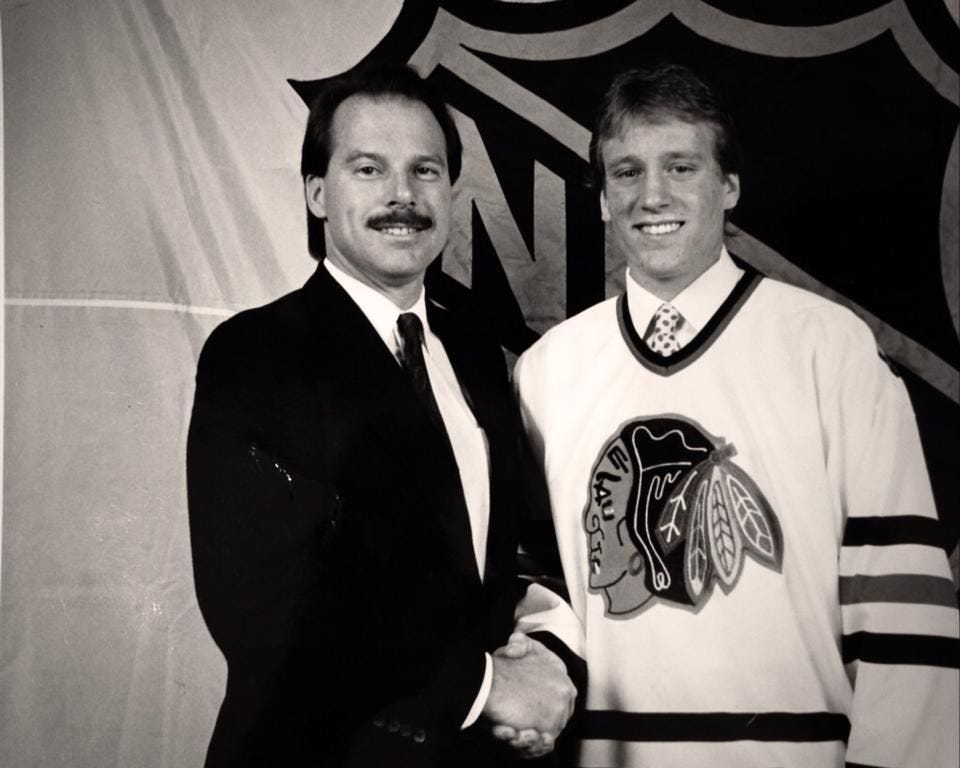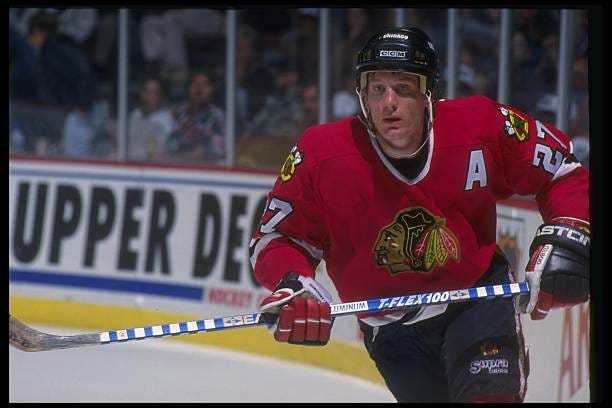Hawks History: Roenick
A look at Roenick's time with the Hawks
Sound.
It evokes emotion. Stirs feelings. Humans are drawn to and influenced by it.
The 90's was defined by sound. Nirvana's guitars shredded through airwaves. Tupac and Biggie influenced a hip-hop wave spanning two coasts. TV's blared laugh tracks from Fresh Prince or reverberated the slapping bass of Seinfeld.
On 1901 W. Madison, that street was defined by a roar that shook the concrete.
While the Chicago Bulls gave fans reason to lose sanity as Michael Jordan battled in the paint, the Blackhawks generated a symphony of chaos with every hit taken into the boards.
The city of broad shoulders had two teams it could become an absolute maniac over.
The Bulls had MJ, Pippen, and Rodman. Six champion teams in the span of eight years. It's no wonder the Bulls overshadowed another special story in the West Side of Chicago.
That early Hawks team was brimming with personality. Ed Belfour, the undrafted Hall of Fame net minder. Local Chicagoan Chris Chelios. Tough-as-nails Captain Dirk Graham. And a scoring power forward with a personality to match his on-ice flair, Jeremy Roenick.
Roenick’s Blackhawks story begins in 1988.
“It’s not that I have a big head… it’s just that I’m sure of myself.”
In the 1988 NHL Draft, the Chicago Blackhawks selected, with the 8th overall pick, a young player straight from high school. Jeremy Roenick had played hockey since he was four years old. The Roenick's moved a lot, forcing Jeremy to play with various teams all over New England. As a fourteen-year-old, the teenager even made weekly flights from the DC area to New Jersey so he could play hockey. Over 75 games, the Boston native posted 300 points. His parents would move back to Massachusetts the following year, where Jeremy enrolled at Thayer Academy.
When the Hawks picked Jeremy Roenick at No. 8, they knew they were getting someone special. Wayne Gretzky even took Roenick out to breakfast with hopes of convincing Roenick to play with his junior league team, the Hull Olympiques. Roenick accepted and would post 70 points in the span of 28 games.
Roenick debuted on Oct. 6, 1988 against the New York Rangers sporting number 51. He would only play 20 games that season, scoring 9 goals and 9 assists. A season which saw the Hawks start to turn things around. The 80's hadn't been too kind to the Hawks. The Hawks had talent, like Steve Larmer and Denis Savard, but struggled to find consistency in net. Despite their goalie troubles, the Blackhawks found themselves in the playoffs against the Red Wings. Roenick was called up.
In an upset, the Hawks knocked out the Red Wings and moved on to the Division Final against St. Louis. In Game 5 against the Blues, Roenick gave Chicago a small taste of who he was. Roenick and Blues defenseman Glen Featherstone got under each others skin. Both players got into it. Featherstone cross-checked a 155lb Roenick in the mouth, costing him two teeth. Roenick skated up to the referee and stuck out his tongue with two broken chiclets. With Featherstone in the penalty box for five minutes, and Roenick for only two, the Hawks scored twice to put them up 2-1. JR's minor penalty would end and he would play the rest of the Hawks powerplay. Roenick, minus two teeth, would score a powerplay goal.
The Hawks would go on to beat the Blues and ultimately fall to a powerful Flames team in the Conference Final. Calgary would move on and win the Stanley Cup.
The following season, Roenick was a full-time member of the Hawks. The Hawks improved during the 1989 season, faring 22 points better in the standings. Roenick contributed with 26 goals and 40 assists. The Hawks were back and they were good. The playoffs started with two grueling battles. The North Stars took the Hawks to game 7 and lost. The Hawks moved on to play against their new sworn enemy in the Blues. After 7 bloody games, the Hawks won. The Oilers waited for them at the Conference Final. Edmonton would win the series 4-2 and go on to take the Cup. Roenick would end up putting 18 points in 20 playoff games.
A trend was starting with this Hawks team. They were good. However, there was always a higher caliber team stopping them from going the full-measure to win the cup. It was Calgary in 1989 and now it was the Oilers. Both teams Stanley Cup Champions. The Hawks were also coached by one of the most toughest coaches. Ever. Mike Keenan ran his team hard. Roenick liked the hard-style of coaching from "Iron Mike," at least that's what he told the press. Roenick would be respected for standing up to Coach Keenan numerous times as a Hawk.
The kid had guts.
Change happened in June of 1990. Denis Savard was traded to the Canadiens. Roenick had given the Hawks management confidence in his scoring abilities to keep him and send off Savard. Roenick filled out his frame to 175 and proved that he could handle the physicality of the NHL, and more. In return for Savard, the Hawks received another future Blackhawk legend in Chris Chelios. There were still some doubts over Roenick’s scoring abilities. Would he be able to fill the void left by Savard?
1991
Jeremy Roenick stands on home-ice for the 42nd NHL All-Star Game. It's the Blackhawks 65th year. Operation Desert Storm just started two days earlier. A Chicago crowd vibrates the air with cheers as Frank Pelico's iconic organ leads Wayne Mesmer into the National Anthem. As that first line is belted out, the crowd splits the air with a roar that drowns out all noise.
Jeremy Roenick already wiped away any worries about his scoring that season. The American born hockey player was on his way to a 94 point season. JR wasn't just a power forward, he was a power forward with skilled hands, and he could score. But Roenick wasn't the sole Hawk standing there as Wayne sang to a ravenous crowd.. Chris Chelios and Steve Larmer stood in front of their home crowd as well.
This was a legendary Hawks team. A rookie goaltender named Eddie Belfour backstopped the Hawks donning a red mask with an eagle painted on the sides. Belfour was on his way to winning the Calder, a Vezina, and a Jennings. Dirk Graham ran the locker room. And through it all, Roenick was a player who spoke his mind. The season as a whole was historic hockey. There was even the St. Patricks Day Massacre, a brawl that strengthened the hatred between the Hawks and the Blues. At the end of the season, the Blackhawks dominated the top of the standings and won the Presidents Trophy. All that was left was a playoff push.
Unfortunately, the North Stars pulled an upset of their own and swept the Hawks in the first round. The Stars, in their last season, made it to the Stanley Cup Final only to lose to Mario Lemieux and the Penguins.
Next season would hopefully be different.
The 1991 season would see Roenick leading the team with 53 goals and 50 assists. This was the first of three straight 100 point seasons for Roenick. The regular season proved disappointing for Hawks fans as the Blackhawks finished lower in the standings. As the Hawks made their way into the playoffs, fans weren't too optimistic about their chances. The Blues waited for their rivals in the first round.
After finding themselves down 2-1 against the Blues, the Hawks would win the series and then sweep their sworn enemy in the Detroit Red Wings. It was at this point that the Hawks had the hockey worlds attention. They looked back to form. Fair-weather Hawk fans tuned back in as the Hawks made their way to the Conference Final and the Oilers. Although Edmonton wasn't the same team that won the Cup in 1990, their reputation was still strong.
And the Hawks swept them.
The Hawks were hot with back-to-back sweeps. The Chicago Bulls were on their way to securing back-to-back champions. Old-time Hawk fans had memories of 1961 replay in their minds. Even fans who were scarred by 1973 had worries laid to rest by Roenick and the Hawks.
The only thing in between the Blackhawks and the Stanley Cup was Lemieux and the Penguins. They had also just swept Boston to make it to the Final.
For all the excitement that roiled in Chicago, it was quickly dissipated as Jaomir Jagr and Lemieux swept the Hawks to their second straight Cup.
Roenick would scored 22 points in 18 playoff games.
In the 1992 season, Roenick would lead the team with a total of 107 points. 50 goals and 57 assists. During the playoffs, the Hawks would be swept in the first round by the Blues.
In 1993, Roenick would score 107 points again with 46 goals and a career-high 61 assists. Each point scored in Chicago caused every fan to shake the Stadium to its roots. Every celebration was deeply recorded in the minds of Hawk fan. The Madhouse on Madison was scheduled to be demolished in the summer of 1994. Jeremy Roenick would give Chicagoans one last roar.
Remember the Roar
The Chicago Stadium's claustrophobic stairways echoed with the footsteps of fans clad in Blackhawk track jackets one last time. It was the 1994 playoffs, and Toronto was in town.
"Remember the Roar" was printed on t-shirts as fans who grew up in this very building attended one last home game.
JR would give those fans one more reason to roar during the 1994 playoffs. In fierce 6-game battle against the Leafs, the Hawks would eventually lose. Roenick would hold the honor of scoring the last goal in that sacred building.
Even though the chapter was closed in the original Madhouse, Roenick was eager to continue fueling the roar across the street in the United Center.
The 1994 season began with a sleepy start. The Lockout caused every hockey fan to wonder when the NHL was going to startup again. In Chicago, the Bulls held the sole attention of every Chicagoan.
Once the season finally started, Roenick would score 34 points in 33 games, missing 15 games due to an injury. The postseason was full of electricity as the Hawks hammered revenge on the Maple Leafs and won the first round in 7 games. The Canucks would fall to the Hawks in the second round, a sweep for the Hawks. The Conference Final, once again, held an opponent who was no push-over. The Detroit Red Wings had ambitions of taking Lord Stanley and beat the Hawks 4-1.
The following season in 1995, Roenick would score 67 points in 66 games. In the playoffs, Chicago would fall in the second round to the Colorado Avalanche.
JR headed into the summer of 1996 as an RFA. Eager to continue his tenure as a Blackhawk. His stat sheet boasted the skills of an elite center. The fans loved him. He was, by all accounts, a Blackhawk by heart. He made a strong case for a 5 year deal with an annual salary of $4mil. Certainly on the expensive side but winning isn't cheap, and you can't put a price on an elite center in their prime.
Bill Wirtz only saw the price.
After 524 games as a Blackhawk, Roenick was quickly traded to the Phoenix Coyotes for a lesser known and unproven talent in Alexei Zhamnov.
Jeremy Roenick would go on to play with a total of 5 teams, 1,363 games, scoring 513 goals and 703 assists, and logged 1,463 minutes in the penalty box.
The one regret Roenick has about his career is that he didn’t play it’s entirety as a Blackhawk.
The Legacy
Roenick scored 267 goals, 329 assists, and 596 points with the Hawks. He was in his prime when he was traded to the Coyotes. The trade broke the heart of many fans. And you can't go back in time and fix things. There will always be "what if's."
What if the Hawks won in 1992? What if Roenick was never traded? What if Chelios and Belfour, soon to be trade casualties themselves, were never traded?
What if Roenick won a Cup?
There is always a "what if."
Much like that kid in 1989 who spat blood in his hands after losing some teeth, Jeremy Roenick gave blood, sweat, and tears while wearing that Blackhawk sweater. There's no "what if's" about Roenick being a warrior on the ice. He punished players in the corners and punished teams on the scoreboard. And there's no longer any "what if's" about the Hall of Fame.
“It’s the Chicago Blackhawks, man.”
Sources:
“Q&A: Jeremy Roenick talks NHL awards, hockey in Vegas, and his place pop culture lore,” Ryan Greene, Las Vegas Sun, 2009
“Remembering the Roar,” Michael Wagner, Bleacher Report, 2008
“Roenick has arrived with the Hawks,” Jeff Jacoubs, The Hartford Courant, 1990
The Chicago Tribune Book of the Chicago Blackhawks: A Decade-by-Decade History, Chicago Tribune, 2017





